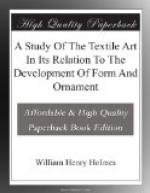[Illustration: FIG. 342. Human figure in Peruvian gobelins, showing characteristic textile convention. From chromolithographs published by Reiss and Stuebel in The Necropolis of Ancon.]
[Illustration: FIG. 343. Human figures from a Peruvian vase, done in free hand, graphic style.]
In order that the full force of my remarks may be appreciable to the eye of the reader, I give an additional illustration (Fig. 343). The two figures here shown, although I am not able to say positively that the work is pre-Columbian, were executed by a native artist of about the same stage of culture as was the work of the textile design. These figures are executed in color upon the smooth surface of an earthen vase and illustrate perfectly the peculiar characters of free hand, graphic delineation. Place this and the last figure side by side and we see how vastly different is the work of two artists of equal capacity when executed in the two methods. This figure should also be compared with the embroidered figures shown in Fig. 348.
The tendencies to uniformity in textile ornament here illustrated may be observed the world over. Every element entering the art must undergo a similar metamorphosis; hence the remarkable power of this almost universally practiced art upon the whole body of decorative design.
[Illustration: FIG. 344. Human figure modified by execution in concentric interlaced style of weaving—1/3.]
That the range of results produced by varying styles of weaving and of woven objects may be appreciated, I present some additional examples. Coiled wares, for instance, present decorative phenomena strikingly at variance with those in which there is a rectangular disposition of parts. Instead of the two or more interlacing series of parallel fillets exhibited in the latter style, we have one radiate and one concentric series. The effect of this arrangement upon the introduced human figure is very striking, as will be seen by reference to Fig. 344, which represents a large tray obtained from the Moki Indians. The figure probably represents one of the mythologic personages of the Moki pantheon or some otherwise important priestly functionary, wearing the characteristic headdress of the ceremony in which the plaque was to be used. The work is executed in wicker, stained in such bright tints as were considered appropriate to the various features of the costume. Referring in detail to the shape and arrangement of the parts of the figure, it is apparent that many of the remarkable features are due to constructive peculiarities. The round face, for example, does not refer to the sun or the moon, but results from the concentric weaving. The oblique eyes have no reference to a Mongolian origin, as they only follow the direction of the ray upon which they are woven, and the headdress does not refer to the rainbow or the aurora because it is arched, but is arched because the construction forced it into this shape. The proportion of the figure is not so very bad because the Moki artist did not know better, but because the surface of the tray did not afford room to project the body and limbs.




